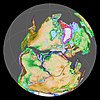Cuche Formation
The sequence of siltstones, shales, and sandstone beds dates to the Late Devonian and Early Carboniferous periods, and has a maximum thickness of 900 metres (3,000 ft).
The Paleozoic succession is overlain by sediments of much younger date; the Late Jurassic Girón and Early Cretaceous Tibasosa Formations.
[5] At time of deposition of the Devonian formations, present-day northern South America was located at the edge of the Paleo-Tethys Ocean on the southern hemisphere.
The remaining stratigraphy of the Cuche Formation appears little affected by this intrusive phase,[6] although slight metamorphism has been identified in later research.
[3] A middle unit of fine-grained sandstones with thin banks of siltstones follows the lower part and an upper sequence of shales with interbedded ferruginous red beds.
[16] In the northern part of the Floresta Massif, the contact between the metamorphic Otengá Stock and the Cuche Formation is formed by the Duga Fault.
[17] Based on the preservation of fossils, the lithologies, syn-sedimentary structures and stratigraphic position, a depositional environment of shallow low energy waters has been proposed, possibly in a lagoonal setting at the edge of a regressional Paleo-Tethys Ocean.
[1][18] Other parts of the Cuche Formation were deposited in a continental environment, evidenced by the red beds and absence of marine fossils and abundant root imprints.
In the middle units of the formation, more and better preserved plant fossils were found alongside bivalves, ostracods (of the genus Welleria) and arthropods.
[30] The fish specimens were found in sediments possibly representing localized transgressive marine incursions into brackish lagoonal settings,[20][31] in all cases associated with the presence of bivalves, ostracods and brachiopods.
[32] The fossil fish assemblage of the Cuche Formation presents a curious mixture of Euramerican "Old Red Sandstone" (Catskills, Greenland, Scotland and the Baltic states)[20] species (Asterolepis and Holoptychius), and Gondwanan taxa (Antarctilamna), suggesting the interchange of species between the paleogeographical regions, possibly at closer distance than is presented in most paleogeographical models.
[38] The specimen (SGC-MGJRG.2018.I.5), assigned with uncertainty to P. bolivianus due to similarities with its holotype, represents the first eurypterid of Colombia and the fourth of South America.





























